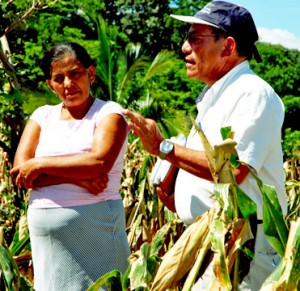 It was unusually hot for the rainy season, but the torrid sun did not dampen farmers’ enthusiasm on the afternoon of 02 September 2009. “This is a variety that yields well, even if we don’t put lots of fertilizer on it, and it has a sweet taste and mills well,” said Francisca Lilian Melgar. Along with 24 other farmers at Lomas de Santiago, El Salvador, she has joined her plot with others to form a communal “mega-plot” of about 25 hectares to test-grow the quality protein maize (QPM) hybrid ‘Oro Blanco’ (White Gold).
It was unusually hot for the rainy season, but the torrid sun did not dampen farmers’ enthusiasm on the afternoon of 02 September 2009. “This is a variety that yields well, even if we don’t put lots of fertilizer on it, and it has a sweet taste and mills well,” said Francisca Lilian Melgar. Along with 24 other farmers at Lomas de Santiago, El Salvador, she has joined her plot with others to form a communal “mega-plot” of about 25 hectares to test-grow the quality protein maize (QPM) hybrid ‘Oro Blanco’ (White Gold).
Each farmer has received seed and other inputs through AgroSalud, a five-year project that started in 2005 with funding from the Canadian International Development Agency to extend the benefits of nutritionally improved staple crops to Latin America and the Caribbean. CIMMYT’s work in the project has been led by maize breeder Gary Atlin, and includes many activities to develop, improve, and disseminate stress resistant, agronomically superior varieties of QPM, a type of maize that contains enhanced amounts of the essential amino acids lysine and tryptophan than normal maize.
Much of the work in El Salvador has been carried out by Héctor Reynaldo Deras Flores, maize researcher with the National Center of Agriculture, Livestock, and Forestry Technology (CENTA). “I would buy seed of this hybrid,” Melgar emphatically told the visitors, who included researchers and extension workers from CENTA, as well as seed producers, policymakers, and CIMMYT staff.
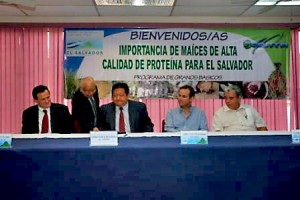 Hours earlier that day, many of the same specialists, along with staff of the Health and Education ministries and representatives of farmer associations, had gathered in the headquarters of El Salvador’s Ministry of Agriculture and Livestock in San Salvador to attend presentations and take part in discussions on the importance of QPM. The event was covered by leading national TV and radio stations, and included presentations by Scott Ferguson, CIMMYT deputy director general for Support Services; Kevin Pixley, associate director of CIMMYT’s Global Maize Program; and Hugo Córdova, retired CIMMYT maize breeder and distinguished scientist. Among other things, presenters reported on achievements of AgroSalud. “In the last five years, we’ve achieved annual increases of 250 kilograms per hectare in the yields of QPM hybrids,” said Córdova, a Salvadoran native. “Because the parent lines were selected under stress conditions, these hybrids perform well in all settings.”
Hours earlier that day, many of the same specialists, along with staff of the Health and Education ministries and representatives of farmer associations, had gathered in the headquarters of El Salvador’s Ministry of Agriculture and Livestock in San Salvador to attend presentations and take part in discussions on the importance of QPM. The event was covered by leading national TV and radio stations, and included presentations by Scott Ferguson, CIMMYT deputy director general for Support Services; Kevin Pixley, associate director of CIMMYT’s Global Maize Program; and Hugo Córdova, retired CIMMYT maize breeder and distinguished scientist. Among other things, presenters reported on achievements of AgroSalud. “In the last five years, we’ve achieved annual increases of 250 kilograms per hectare in the yields of QPM hybrids,” said Córdova, a Salvadoran native. “Because the parent lines were selected under stress conditions, these hybrids perform well in all settings.”
Ferguson, Pixley, and Córdova also met with CENTA director Antonio René Rivera Magaña to discuss ways of promoting adoption and marketing of Oro Blanco. “With QPM we’ve pushed, pushed, pushed,” Pixley said. “Now we need to create some ‘pull’—we have to promote the product in a way that creates demand.” Studies have shown that QPM can improve human nutrition and health in populations that depend heavily on maize as food but, according to Pixley, farmers are interested first and foremost in higher yields— something that Oro Blanco and AgroSalud products appear to offer.
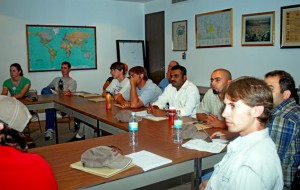 Many young and eager minds passed through CIMMYT-Mexico this past month. Three students from the University of Wisconsin, USA, visited from 8-16 August while 12 from Texas A&M University, USA, stayed from 12-22 August. The goals of both groups were to further their understanding of agricultural systems in Mexico and to observe CIMMYT’s work with international research.
Many young and eager minds passed through CIMMYT-Mexico this past month. Three students from the University of Wisconsin, USA, visited from 8-16 August while 12 from Texas A&M University, USA, stayed from 12-22 August. The goals of both groups were to further their understanding of agricultural systems in Mexico and to observe CIMMYT’s work with international research. It was unusually hot for the rainy season, but the torrid sun did not dampen farmers’ enthusiasm on the afternoon of 02 September 2009. “This is a variety that yields well, even if we don’t put lots of fertilizer on it, and it has a sweet taste and mills well,” said Francisca Lilian Melgar. Along with 24 other farmers at Lomas de Santiago, El Salvador, she has joined her plot with others to form a communal “mega-plot” of about 25 hectares to test-grow the quality protein maize (QPM) hybrid ‘Oro Blanco’ (White Gold).
It was unusually hot for the rainy season, but the torrid sun did not dampen farmers’ enthusiasm on the afternoon of 02 September 2009. “This is a variety that yields well, even if we don’t put lots of fertilizer on it, and it has a sweet taste and mills well,” said Francisca Lilian Melgar. Along with 24 other farmers at Lomas de Santiago, El Salvador, she has joined her plot with others to form a communal “mega-plot” of about 25 hectares to test-grow the quality protein maize (QPM) hybrid ‘Oro Blanco’ (White Gold). Hours earlier that day, many of the same specialists, along with staff of the Health and Education ministries and representatives of farmer associations, had gathered in the headquarters of El Salvador’s Ministry of Agriculture and Livestock in San Salvador to attend presentations and take part in discussions on the importance of QPM. The event was covered by leading national TV and radio stations, and included presentations by Scott Ferguson, CIMMYT deputy director general for Support Services; Kevin Pixley, associate director of CIMMYT’s Global Maize Program; and Hugo Córdova, retired CIMMYT maize breeder and distinguished scientist. Among other things, presenters reported on achievements of AgroSalud. “In the last five years, we’ve achieved annual increases of 250 kilograms per hectare in the yields of QPM hybrids,” said Córdova, a Salvadoran native. “Because the parent lines were selected under stress conditions, these hybrids perform well in all settings.”
Hours earlier that day, many of the same specialists, along with staff of the Health and Education ministries and representatives of farmer associations, had gathered in the headquarters of El Salvador’s Ministry of Agriculture and Livestock in San Salvador to attend presentations and take part in discussions on the importance of QPM. The event was covered by leading national TV and radio stations, and included presentations by Scott Ferguson, CIMMYT deputy director general for Support Services; Kevin Pixley, associate director of CIMMYT’s Global Maize Program; and Hugo Córdova, retired CIMMYT maize breeder and distinguished scientist. Among other things, presenters reported on achievements of AgroSalud. “In the last five years, we’ve achieved annual increases of 250 kilograms per hectare in the yields of QPM hybrids,” said Córdova, a Salvadoran native. “Because the parent lines were selected under stress conditions, these hybrids perform well in all settings.”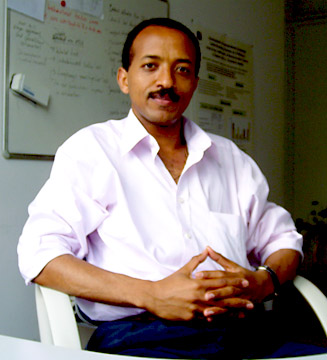 Girma Tesfahun, post doctoral fellow based at CIMMYT’s office in Addis Ababa, was elected president of the Agricultural Economics Society of Ethiopia (AESE) for the next two years. The AESE’s general assembly elected Tesfahun at their 12th annual conference from 14-15 August 2009 in Addis Ababa. The executive committee has five members and includes senior economists from universities, national agricultural research programs, the private sector, and staff from the
Girma Tesfahun, post doctoral fellow based at CIMMYT’s office in Addis Ababa, was elected president of the Agricultural Economics Society of Ethiopia (AESE) for the next two years. The AESE’s general assembly elected Tesfahun at their 12th annual conference from 14-15 August 2009 in Addis Ababa. The executive committee has five members and includes senior economists from universities, national agricultural research programs, the private sector, and staff from the 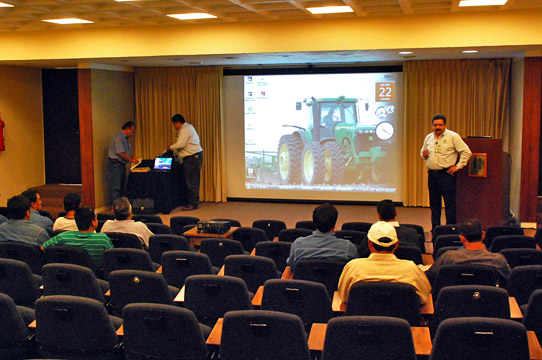 Around 20 employees from different departments in El Batán gathered at the auditorium and in La Redonda for a course on agricultural machinery maintenance and safety on 22 June 2009. The instructors, Jesús López Torres, Álvaro García, and Francisco Javier Reyes, were machinery experts from the
Around 20 employees from different departments in El Batán gathered at the auditorium and in La Redonda for a course on agricultural machinery maintenance and safety on 22 June 2009. The instructors, Jesús López Torres, Álvaro García, and Francisco Javier Reyes, were machinery experts from the 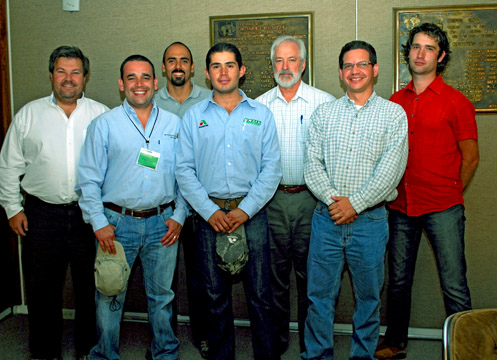 To get a ground-level idea of how
To get a ground-level idea of how 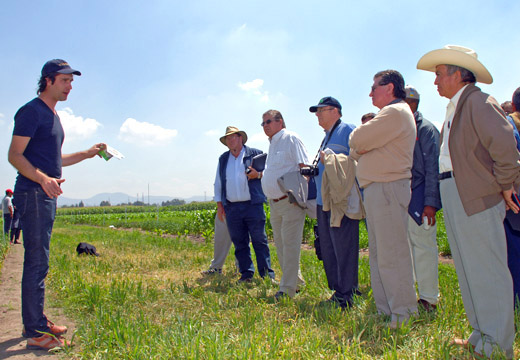 About 17 people from the American Confederation of Associations in Sustainable Agriculture (CAAPAS, by its Portuguese acronym) visited El Batán on 23 July 2009. The group visited CIMMYT as part of their international meeting on direct seeding and sustainable agriculture.
About 17 people from the American Confederation of Associations in Sustainable Agriculture (CAAPAS, by its Portuguese acronym) visited El Batán on 23 July 2009. The group visited CIMMYT as part of their international meeting on direct seeding and sustainable agriculture.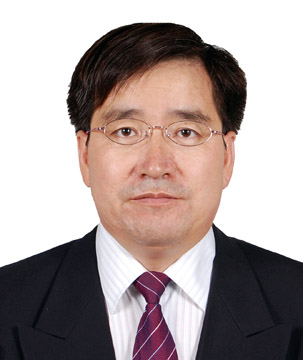 The
The